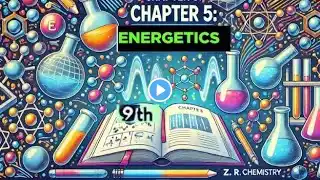
Ch#11| Bioenergetics | Lec # 13| Respiration(Types of respiration) Aerobic and Anaerobic Respiration
Respiration: Living organisms need energy to carry on their vital activities. This energy is provided from within the cells by the phenomenon of respiration. Respiration is the universal process It can be defined as “Respiration is a series of oxidative and reductive reactions as the result H₂O is produced and energy in the form of ATP is formed" Living organisms need energy to carry on their vital activities. In biology the term respiration is used in two ways. Generally the respiration means. "The exchange of respiratory gases (CO2 and O₂) between the organism and its environment", exchange of gases is actually called external respiration/ breathing. Cellular respiration is the process by which energy is made available to cells in a step by step breakdown of C-chain molecules in the cells. The cellular respiration is divided into two types. (i) Aerobic respiration (ii) An-aerobic respiration Aerobic and An-aerobic Respiration: Aerobic respiration which occur in the presence of free or molecular O2. Aerobic respiration which occurs in the absence of free O2. The most common fuel used by the cell to get energy by cellular respiration is glucose. Before entering a mitochondrion, the glucose molecule is split to form two molecule of pyruvic acid. Cell process pyruvic acid in three major ways. (i) Alcoholic Fermentation (ii) Lactic Acid Fermentation (iii) Aerobic Respiration The first two included as anaerobic respiration in which break down of glucose occurs in the absence of oxygen. During aerobic respiration complete while water and energy released". Fermentation: It consists of glycolysis followed by reduction of pyruvate by NADH to either lactic acid alcohol and CO2. This pathway operates anaerobically. Types Of Fermentation: (i) Alcoholic Fermentation: In Primitive cells and in some eukaryotic cells such yeast, pyruvic acid is further broken down by alcoholic fermentation into alcohol (C2H2OH) And CO2. (i) Lactic Acid Fermentation: lactic acid fermentation each pyruvic acid molecule is converted into lactic acid (C3H6O3) the absence of Oxygen gas. Significance: Both alcohlic and lactic acid fermentations yield relatively small amounts of energy from glucose molecule. During anaerobic respiration: Only about 2% of the energy present with in the chemical bonds of glucose converted into adenosine triphosphate. Two ATP produced per glucose during fermentation is equivalent to 14.6 Kcal. But fermentation is a way to produce ATP even through O2 is temporarily in limited supply . Role of Mitochondria In Respiration: Mitochondria are large granular or filamentous organelles that are distributed through the cytoplasm of and plant cells. Each mitochondrion is constructed to an outer enclosing membrane and inner membrane with elaborate folds or cristae that extend into interior of the organelle. Mitochondria play a part in cellular respiration by transfering the energy of organic molecules to the bonds of ATP. A large battery of enzymes and coenzymes slowly release energy from the glucose molecule. Thus mitochondria are houses" that produce energy necessary for many cellular functions. adenosine Triphosphate. What is its importance? Adenosine triphosphate, generally abbreviated "ATP" is a compound found in every living cell and is one of the essential chemical of life. It plays the key role in most biological energy transformations. Conventionally "P" stands for the entire phosphate group. The second and third phosphate represent the so called "high energy" bond. If these are broken by free is to the other bonds in the ATP molecule. The breaking of the terminal phosphate of ATP releases about 7.3 Kcal of energy. The high energy phosphate bond enables the cell to accumulate a great quantity of energy in very small space and keeps it ready for use as soon as it is needed for various functions. Example, Synthesis of more complex compounds, active transport across the cell membrane, muscular contraction, and ne conduction etc. Composition: The ATP molecule is composed of a purine base (adenine), a 5-carbon sugar (ribose) and three phosphate groups at position 5 (carbon 5 in the ribose ring) of ribose molecule. Formation: (i) The first step in the formation of ATP, is the combination of the base (adenine) with the pentose sugar (ribose). This combination is called a nucleoside. (ii) With the addition of phosphate, the corresponding nucleoside is converted into adenosine monophosphate (AMP) (iii) Addition of another phosphate group results in the formation of adenosine diphosphate (ADP) (iv) The addition of a third phosphate group converts ADP into adenosine triphosphate, i.e., ATP. And If you like the video. Please like, share and subscribe channel. Thank you for watching my video. @riffatjahan channel Link... / @riffatjahan



















